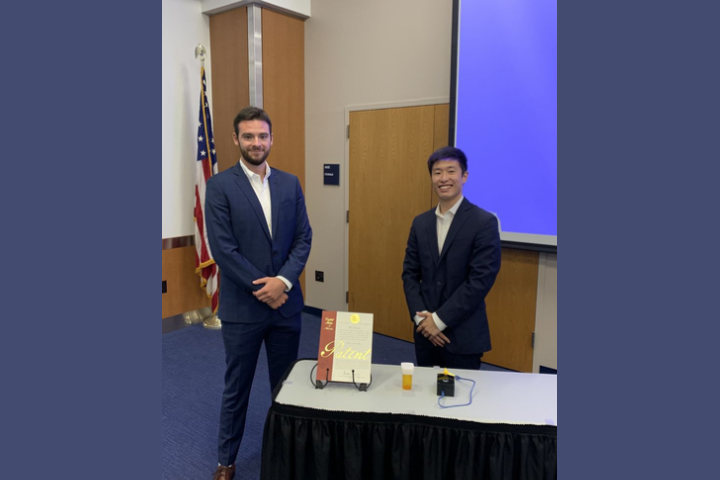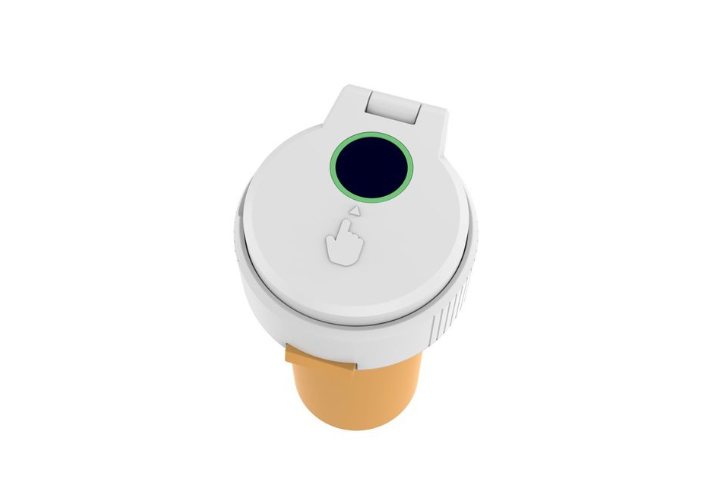From VIRGINIA GAZETTE By ABIGAIL ADCOX

Pictured from left are Alexander Colton and Joseph W. White. Courtesy of Alexander Colton (HANDOUT)
A pill bottle cap requiring a thumbprint to open, measuring the number of pills left in each bottle and tracking any openings that are unusual, might soon be hitting the market thanks to two William & Mary alumni.
Alexander Colton and Joseph White first came up with the idea as sophomores at W&M. Having seen several friends and family members suffer from opioid addiction first-hand, they wanted to be part of a solution.
“We know how devastating it was for our families and for the families of the people that we have known,” said White. “We want to do what we can to prevent this from happening to anyone else’s family because it’s not something we would wish on our worst enemy. ”
White added that he grew up in rural Winchester and saw how the opioid epidemic affected his own community.
Their company, FortisKap, first started in 2017 with a hand-drawn sketch of the product. Today, they have a prototype of their pill cap.
“Once we started talking to William & Mary that we are really into this, they were able to open up a lot of doors and help us,” said Colton.
Both Colton and White have graduated from W&M and have since been working on building their company. The two now split their time between Delaware and Richmond, where research and design work is ongoing for their company.
In December 2020, they received their official patent from the United States Patent and Trademark Office.
In their prototype, each cap comes with an embedded biometric security system that will recognize the thumbprint of registered users. Each of the registered users will be required to place their finger on the thumbprint before the chute will open, releasing the pills.
The cap will also be able to scan the bottle to report how many pills were taken and how many are left each time it is opened. If the cap is opened at an unusual time or a lot of pills are taken at one time, it will also register and collect that information.
The user’s information will be made available to that person through an online portal.
“We can record the data analytics and then after the fact show them and say ‘hey these are the changes we recommend you make’,” said Colton. “Very similar to how MyFitnessPal imports a diet and says you shouldn’t eat this or that.”
White explained that their hope with the online platform is to streamline information from the prescription medication user and the provider who prescribed the medication. Users would also have the opportunity to opt-in or out.

A photo of two William & Mary alum’s pill bottle cap with a thumbprint. Courtesy of Alexander Colton (HANDOUT)
“Having something that secures the medication from the household is a preventative measure,” Colton said. “That says I’m not going to steal this and if you do steal it … you’re getting real-time notifications that your FortisKap has been tampered by an unauthorized user.”
Colton said that they are hoping to prevent other members of a household from taking pills not prescribed to them, while also holding users accountable for taking their medication.
They are also planning a rewards program that gives incentives to the user to take their medication properly. Their hope is that down the line incentives such as health insurance companies lowering FortisKap’s users deductibles will be available.
Other products with a similar mission already exist in the market, such as a cap that displays the time it was last opened, but as Colton explains it, theirs targets both medication adherence and security of the bottle.
Right now, the two are planning a clinical trial to test out their product and contacting providers who could carry their product down the line.
Colton said that ideally, they would like to partner with an integrated delivery network, such as Sentara Healthcare or INOVA, that has a large client base and streamlined systems.
They anticipate the product hitting the market in Virginia in the spring.
“We’re really excited for our launch essentially,” said Colton. “It will be the first pilot program for FortisKap, it will be the first time consumers really benefit from the product.”
Abigail Adcox, abigail.adcox@virginiamedia.com, 757-264-8149






